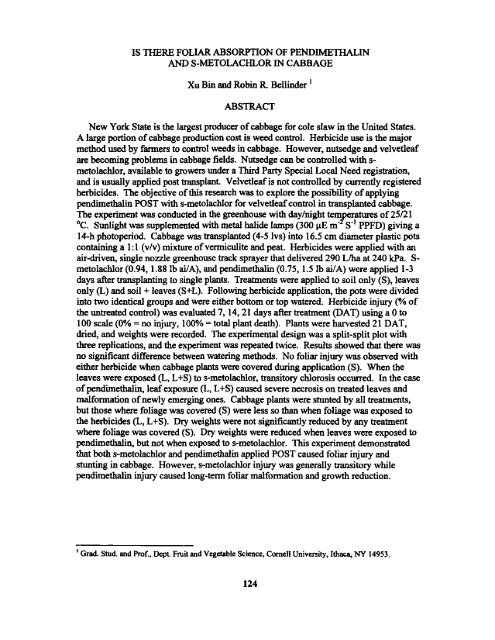Vol. 54â2000 - NorthEastern Weed Science Society
Vol. 54â2000 - NorthEastern Weed Science Society
Vol. 54â2000 - NorthEastern Weed Science Society
You also want an ePaper? Increase the reach of your titles
YUMPU automatically turns print PDFs into web optimized ePapers that Google loves.
IS TIIERE FOLIAR ABSORPTION<br />
AND S-METOLACHLOR<br />
OF PENDIMETIIALIN<br />
IN CABBAGE<br />
Xu Bin and Robin R. Bellinder I<br />
ABSTRACT<br />
New York State is the largest producer of cabbage for cole slaw in the United States.<br />
A largeportionof cabbageproductioncost is weedcontrol. Herbicideuse is the major<br />
method used by farmers to control weeds in cabbage. However, nutsedge and velvetleaf<br />
are becoming problems in cabbage fields. Nutsedge can be controlled with s<br />
metolachIor, available to growersunder a Third Party Special Local Need registration,<br />
and is usually applied post transplant. Velvetleaf is not controlled by currently registered<br />
herbicides. The objective of this research was to explore the possibility of applying<br />
pendimethalin POST with s-metoiachior for velvetleaf control in transplanted cabbage.<br />
The experiment was conducted in the greenhouse with day/night tem~atures of25121<br />
·C. Sunlight was supplemented with metal halide lamps (300 ~E m" S-I PPFD) giving a<br />
14-h photoperiod. Cabbage was transplanted (4-5Ivs) into 16.5 cm diameter plastic pots<br />
containinga 1:1(v/v) mixtureofvenniculite andpeat. Herbicideswere appliedwith an<br />
air-driven,single nozzle greenhousetracksprayerthatdelivered290 L/haat 240 kPa. S<br />
metolachior (0.94, I.88lb ailA), and pendimethalin (0.75, I.5lb ailA) were applied 1-3<br />
days after tranaplanting to single plants. Treatments were applied to soil only (S), leaves<br />
only (L) and soil + leaves (S+L). Following herbicide application, the pots were divided<br />
intotwo identicalgroupsandwereeitherbottomor topwatered. Herbicideinjury(% of<br />
the untreated control) was evaluated 7, 14,21 days after treatment (OAT) using a 0 to<br />
100 scale (0010~ no injury, 100% ~ total plant death). Plants were harvested 21 DAT,<br />
dried,andweightswere recorded.Theexperimentaldesignwas a split-splitplot with<br />
threereplications, and the experiment was repeated twice. Results showed that there was<br />
no significantdifferencebetweenwateringmethods. No foliarinjurywas observedwith<br />
either herbicide when cabbage plants were covered during application (S). When the<br />
leaves were exposed(L. L+8) to s-metolachlor, transitorychlorosisoccurred. In the case<br />
of pendimethalin,leaf exposure(L, L+S) causedseverenecrosison treatedleaves and<br />
malformationof newly emergingones. Cabbageplantswere stuntedby all treatments,<br />
but those where foliage was covered (S) were less so than when foliage was exposed to<br />
the herbicides (L, L+S). Dry weights were not significantly reduced by any treatment<br />
wherefoliage was covered(S). Dryweightswerereducedwhenleaves were exposedto<br />
pendimethalin,butnotwhenexposedto s-metolachlor.This experimentdemonstrated<br />
that both s-metolachlor and pendimethalin applied POST caused foliar injury and<br />
stuntingin cabbage. However,s-metolachlorinjurywas generallytransitorywhile<br />
pendimethalininjurycausedlong-termfoliarmalformationandgrowthreduction.<br />
I Grad.Stud.andProf.,Dept FruitandVegetable<strong>Science</strong>,CornellUniversity,Ithaca,NY 14953.<br />
124
















